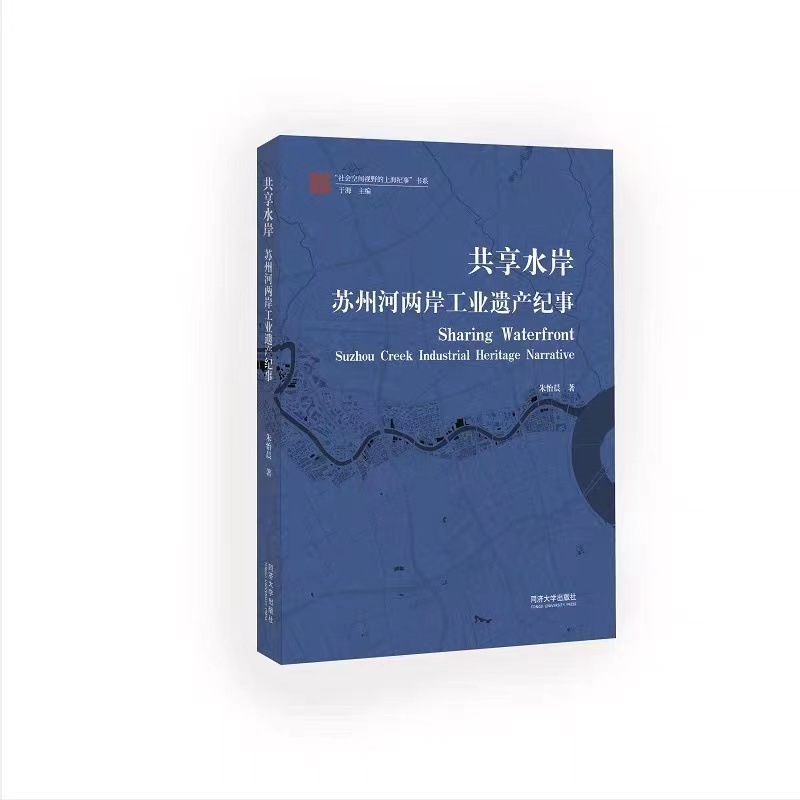It is also a living history museum, a river heritage | space | history museum
Dr. Zhu Yichen's book "Shared Waterfront: A Chronicle of Industrial Heritage on both sides of Suzhou River" focuses on the renewal of industrial heritage on both sides of Suzhou River, and explores the driving force behind the transformation of waterfront industrial heritage space from the perspective of social space. Through the description of over 60 industrial heritage sites along the Suzhou riverbank, the unique charm of the Suzhou riverbank and the development history of Shanghai carried by the waterfront industrial heritage are presented. The importance of transforming the waterfront from an industrial space to a social space is explained, and the readers are presented with a beautiful future vision of sharing the waterfront.
"A living museum of history"
The waterfront in Shanghai has shifted from a production shoreline to a landscape shoreline, from a closed shoreline monopolized by factories, warehouses, docks, units, and communities to an open shoreline shared by the public today. This not only reflects the transformation of urban planning and design ideas, but also demonstrates the social spatial evolution under the transformation of production relations.
Every generation can witness earth shattering changes in industrial architecture, from its flourishing development, to its shutdown and relocation, and then to its protection and utilization. The industrial heritage along the Suzhou River is no exception. At present, a consensus has been reached on the protection of industrial heritage along the Suzhou River bank. However, facing the future, it is still worth exploring how to combine the protection of relatively closed architectural heritage with urban development.
The "Shared Waterfront" proposes that the protection and utilization of industrial heritage should start from the principle of sharing, be used by more subjects, and become a shared urban public landscape. The goal of "sharing waterfront" breaks free from the limitations of individual building repair and protection, and focuses on enhancing the public value of urban waterfront resources. It coincides with the current concept of "returning the river to the people, returning the river to the people" in waterfront space construction. The five dimensions of waterfront sharing proposed in the book also provide actionable design methods and strategies for the renewal and revitalization of waterfront industrial heritage, a special architectural type, and its surrounding communities.
Suzhou River is located in the western part of Shanghai city, flowing through multiple areas such as Zhabei, Jing'an, Huangpu, and Xuhui from the old city area of Shanghai. It is the main river with the longest history in Shanghai and carries rich urban memories. It is also a rare urban spatial resource for Shanghai as a high-density city. Before modern times, both sides of Suzhou River had long been important industrial, commercial, cultural, and residential areas in the urban area of Shanghai. With the development of the city, the banks of Suzhou River have undergone changes in different periods, forming a unique urban landscape.
The Suzhou River bank is home to buildings of various periods and styles, such as European style buildings, old western-style houses from the Republic of China era, and industrial heritage buildings. The style and historical background of these buildings showcase the diverse cultural characteristics of the Suzhou River bank. In history, due to the convenient shipping of Suzhou River, its waterfront has become the location of many factories, warehouses, and docks, presenting a prosperous scene of "warehouses and factories". Famous warehouses such as Jincheng Bank, Sihang Warehouse, Bank of Communications Warehouse, Moganshan Road Industrial Zone, and Guomian First Factory are all well-known manufacturing hubs in Shanghai, but they have also become stinky ditches due to the discharge of industrial wastewater and domestic sewage. Starting from the 1980s, Shanghai initiated comprehensive environmental management of the Suzhou River, with the closure and relocation of factories, land transfer, real estate development, and the construction of ecological green spaces.
With the comprehensive improvement of the environment along the Suzhou River, the natural characteristics of the ecological environment have gradually been restored, becoming a rare and unique urban living place in Shanghai. Amidst the hustle and bustle, a relatively peaceful and natural world has been opened up. The riverbank has formed patches of greenery and parks, and the river is once again filled with various fish and birds, not only adding natural elements to the city, but also providing a place for leisure, entertainment, and sports for citizens. Many Shanghai citizens have regained the natural fun of their childhood and become the contemporary urban memory of the new Shanghai citizens.
The ecological return of the Suzhou River bank has become a beautiful scenery in the center of Shanghai, and in the process, the industrial heritage left by those former industrial hubs has also highlighted its unique charm. At the same time, these former industrial spaces also contain rich Shanghai stories, becoming a living historical museum.
"The" sharing "and regeneration of industrial heritage"
The industrial heritage along the Suzhou River is one of the unique charms of the Suzhou River Basin. These industrial heritage sites record the history of Shanghai's urban development and are an important symbol of Shanghai's urban culture.
From the late 19th century to the mid-20th century, the Suzhou River Basin became an important industrial area in Shanghai, where some famous Shanghai enterprises, chambers of commerce, and factories were located, such as the Shanghai General Chamber of Commerce, Xintai Warehouse, Sihang Warehouse, Jardine Matheson Packaging Factory, Shanghai Brewery, Xinhe Textile Factory, Zhonghua Bookstore, and so on. These industrial heritages not only showcase the architectural styles of different periods, but also record the history of Shanghai's industrial development. In the process of urban renewal in Shanghai, many old factories have been reused and transformed into cultural and commercial spaces such as art centers, creative parks, restaurants, and cafes, bringing new vitality and charm to these industrial heritage sites, becoming one of the highlights of Shanghai's urban renewal.
The book describes four stages of industrial heritage renewal on the banks of the Suzhou River: in the 1990s, the industrial heritage was reused as a symbol of the Suzhou River's "art warehouse" group; At the beginning of the 21st century, the M50 Creative Park gradually emerged as a representative creative industry cluster area; The government led waterfront redevelopment around 2010, taking the Shanghai World Expo as an opportunity; Since the World Expo, the shaping of riverside public spaces and the renewal of industrial heritage have been carried out with the integration of both sides of the Pujiang River and the urban design of both sides of the Suzhou River as symbols. The author summarizes the historical process of industrial heritage renewal on the banks of Suzhou River as a new urban landscape characterized by "shared waterfront".
"From industrial space to social space"

The author proposes five "sharing" dimensions for the protection and reuse of Suzhou Riverside Industrial Heritage, namely, diachronic, permeable, time-sharing, diverse, and daily, in order to achieve the regeneration of industrial heritage from industrial space to social space.
The diachronic nature reflects the historical accumulation of industrial heritage in the process of historical evolution. Protection and regeneration are not only material carriers themselves, but also require the presentation of their historical origins, place memories, spatial stories, etc. in innovative spatial forms, achieving a design strategy transformation from "focusing on form" to "focusing on the formation process.".
Permeability is mainly reflected in the accessibility of spatial locations. Public accessibility is an extremely important indicator that reflects the transformation of industrial heritage into social space. In the industrial era, waterfront space often has linear isolation facilities such as railways, roads, and walls on the side facing the urban hinterland due to transportation and production needs. Industrial space becomes a barrier between the urban hinterland and waterfront space. The intervention of permeability indicators is of great significance in promoting the connection between urban hinterland and waterfront spaces during the renewal process.
Time sharing is an important strategy for sharing urban spatial resources. In situations where spatial resources, especially urban public spaces, are relatively scarce, it is necessary to reflect the social nature of the space, encourage public participation, and attract public activities. Planning the usage status of the space at different time periods and reflecting it in the planning and design of the public space system will effectively promote the revitalization of waterfront space, present local characteristics and urban cultural connotations.
The proposal of diversity is mainly aimed at the relatively single content planning of the current industrial heritage renovation process. Therefore, strategies to promote diversified functional configuration will effectively enhance the diversity of users and the formation of industrial and service chains, as well as promote service-oriented functions for surrounding communities, attract more public participation, and stimulate the occurrence of various public activities.
The intervention of daily life emphasizes the creation of humanized places in the regeneration of industrial heritage, placing scenes closer to the daily lives of ordinary citizens. Humanized places shape spatial forms that can promote occasional and social behavior. In addition to the buildings of industrial heritage, the rich external space and integration with the surrounding community street network, as well as the overall community-based renewal of the surrounding urban environment, can make the revitalization, regeneration, and utilization of industrial heritage more down-to-earth, becoming an opportunity to shape local urban culture.
The establishment of these five shared dimensions provides actionable renewal strategies for the revitalization and regeneration of Suzhou River Industrial Heritage from industrial space to social space.
"The Future Vision of Shared Waterfront"
With the process of urbanization, waterfront areas, as important spaces in cities, not only carry the historical memory of urban development, but also have important ecological, cultural, and economic values. Suzhou River, as one of the most important rivers in Shanghai, combined with the precious resources of waterfront industrial heritage, makes the waterfront space unique and charming. Protecting and developing the waterfront space of Suzhou River is an important issue currently facing, which not only meets the needs of urban development, but also takes into account the ecological, cultural, and social needs.
The sharing concept and updating strategy advocated in this book will be an important direction for the development of Suzhou Riverside Water Space. Suzhou Riverside Water Space should fully utilize its functions as a urban public space, create a place for citizens to live, entertain, and relax, and provide diversified services and experiences. At the same time, the waterfront space of Suzhou River should also fully utilize its functions as an urban ecosystem, create a green urban corridor, and provide a beautiful landscape that integrates nature and the city. In addition, the waterfront space of Suzhou River should fully utilize its function as urban cultural heritage, protect and inherit its long history and culture, so that citizens and tourists can better understand and experience the history and achievements of Shanghai's urban development.
This book extends the renewal of waterfront industrial heritage from the protection and restoration of architecture to the renewal and development of urban space. It also proposes the principles and methods of sharing in the creation of waterfront social space, and demonstrates to readers that under the concept and guiding principles of sharing, the Suzhou River bank will become a stage for carrying diverse functions and spatial forms in the center of Shanghai. It will also integrate natural ecological environment, profound historical memories, and fashionable vitality.
The book "Shared Waterfront" was included in the "Shanghai Chronicles from a Social Space Perspective" series edited by Professor Yu Hai from Fudan University. Using "history as the longitude and place as the latitude" and "historical consciousness and spatial sensitivity" to describe the historical evolution of the space along the Suzhou River, it fills the gap of "Shanghai's spatial chronicles, stories without rivers are always lacking".
"Shared Waterfront: A Chronicle of Industrial Heritage on Both Sides of Suzhou River" by Zhu Yichen, published by Tongji University Press




